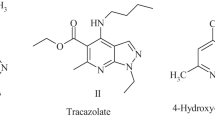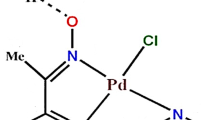Abstract
From a wild type strain of Ehrlich ascites tumor (EATWT) sublines resistant to daunorubicin (EATDNM), etoposide (EATETO), and cisplatinum (EATCIS) have been developed in vivo. Increase in survival and cure rate caused by adriamycin (doxorubicin) have been determined in female NMRI mice which were inoculated i. p. with EAT cells. Adriamycin concentrations causing 50% inhibition of 3H-thymidine (ICT) and 3H-uridine incorporation (ICU) and intracellular adriamycin steady-state concentrations (SSC) were measured in vitro. Adriamycin resistance increased and SSC decreased in the following sequence: EATWT — EATCIS — EATDNM — EATETO. When ICT and ICU were corrected for intracellular adriamycin concentrations in consideration of the different SSC (ICTC, ICUC), ICTC and ICUC still varied up to the 3.2 fold in EATCIS, EATDAM and EATETO in comparison to EATWT. Thus, in addition to different SSC other factors must be responsible for adriamycin resistance. Therefore, enzymes which may play a role in the cytotoxicity related to adriamycin metabolism (NADPH-cytochrome P-450 reductase, NADPH-glutathione reductase, NADP-glucose-6-phosphate dehydrogenase, NADP-isocitrate dehydrogenase) were measured. In contrast to the other parameters determined, NADPH-glutathione reductase was significantly (p<0.01) increased up to the 3.2 fold parallel to adriamycin resistance as determined by increase in life span, cure rate, ICTC, and ICUC, respectively. It is concluded that high activities of NADPH-glutathione reductase may contribute to an increase in adriamycin resistance of malignant tumors.
Similar content being viewed by others
References
Babson JR, Abell NS, Reed DJ (1981) Protective role of the glutathione redox cycle against adriamycin-mediated toxicity in isolated hepatocytes. Biochem Pharmacol 30: 2299–2304
Bachur N, Gordon GL, Gee MV (1977) Anthracycline antibiotic augmentation of microsomal electron transport and free radical formation. Mol Pharmacol 13: 901–910
Batist G, Cowan KH, Curt G, Katki AG, Myers CE (1986) Increased glutathione S-transferase activity in drug treated human breast cancer cells. Proc Amer Ass Cancer Res 26: 345
Begleiter A, Grover J, Froese E, Goldenberg GJ (1983) Membrane transport, sulfhydryl levels and DNA cross-linking in Chinese hamster ovary cell mutants sensitive and resistant to melphalan. Biochem Pharmacol 32: 293–300
Bergmeyer HU, Grawehl K, Grassl M (1974) Enzyme als biochemische Reagentien. Glutathion-Reduktase. In: Bergmeyer HU (ed) Methoden der enzymatischen Analyse, 3. ed, Vol 1, Verlag Chemie, Weinheim, pp 494–495
Bernt E, Bergmeyer HU (1974) Isozitrat-Dehydrogenase. UV-Test. In: Bergmeyer HU (ed) Methoden der enzymatischen Analyse, 3 ed, Vol 1, Verlag Chemie, Weinheim, pp 661–663
Bozzi A, Mavelli I, Mondovi B, Strom R, Rotilio G (1979) Differential sensitivity of tumor cells to externally generated hydrogen peroxide. Role of glutathione and related enzymes. Cancer Biochem Biophys 3: 135–141
Calcutt G, Connors TA (1963) Tumour sulfhydryl levels and sensitivity to the nitrogen mustard merophan. Biochem Pharmacol 12: 839–845
Crathorn AR, Roberts JJ (1966) Mechanism of the cytotoxic action of alkylating agents in mammalian cells and evidence for the removal of alkylated groups from deoxyribonucleic acid. Nature 211: 150–153
Crooke ST, Duverney VH, Mong S (1981) Molecular pharmacology of anthrycyclines. In: Sartorelli AC, Lazo JS, Bertino JR (eds) Molecular Actions and Targets for Cancer Chemotherapeutic Agents, Bristol-Myers Cancer Symposia, Vol 2, Academic Press, New York London Toronto Sydney San Francisco, pp 137–162
Danø K (1973) Active outward transport of daunomycin in resistant Ehrlich ascites tumor cells. Biochim Biophys Acta 323: 466–483
Giavazzi R, Scholar E, Hart IR (1983) Isolation and preliminary characterization of an adriamycin-resistant murine fibrosarcoma cell line. Cancer Res 43: 2216–2222
Goldenberg GJ, Vanstone CL, Israels LG, Ilse D, Bihler I (1970) Evidence for a transport carrier of nitrogen mustard in nitrogen mustard-sensitive and -resistant LS178Y lymphocytes. Cancer Res 30: 2285–2291
Hirono I (1960) Non-protein sulphydryl group in the original strain and sub-line of the ascites tumour resistant to alkylating agents. Nature 186: 1059–1060
Hoensch H, Woo CH, Raffin SB, Schmidt R (1976) Oxidative metabolism of foreign compounds in the rat small intestine: cellular localization and dependence on dietary iron. Gastroenterology 70: 1063–1070
Kappus H, Sies H (1981) Toxic drug effects associated with oxygen metabolism: redox cycling and lipid peroxidation. Experientia 37: 1233–1241
Kohn K (1979) DNA as a target in cancer chemotherapy: measurement of macromolecular DNA damage produced in mammalian cells by anticancer agents and carcinogens. In: DeVita VT Jr, Busch H (eds) Methods in Cancer Research, Vol XVI, Cancer Drug Development, Part A, Academic Press, New York San Francisco London, pp 291–345
Löhr GW, Waller HD (1974) Glucose-6-Phosphat-Dehydrogenase. In: Bergmeyer HU (ed) Methoden der enzymatischen Analyse, 3. ed, Vol 1, Verlag Chemie, Weinheim, pp 673–681
Londos-Gagliardi D, Baurain R, Robert J, Aubel-Sadron G (1982) Metabolism of daunorubicin in sensitive and resistant Ehrlich ascites tumor cells. Determination by high pressure liquid chromatography. Cancer Chemother Pharmacol 9: 45–48
Roberts JJ, Crathorn AR, Brent TP (1968) Repair of alkylated DNA in mammalian cells. Nature 218: 970–972
Scheulen ME (1983) Kumulative Anthracyclin-Kardiotoxizität. Möglichkeiten für eine kardioselektive Protektion durch Begleittherapie mit Isozitrat und Niacin. In: Schmidt CG (ed) Aktuelle Probleme der Hämatologie und internistischen Onkologie. Präklinische und klinische Untersuchungen. Springer, Berlin Heidelberg New York, pp 125.139
Scheulen ME, Kappus H, Thyssen D, Schmidt CG (1981) Redox cycling of Fe(III)-bleomycin by NADPH-cytochrome P-450 reductase. Biochem Pharmacol 30: 3385–3388
Seeber S, Loth H, Crooke ST (1980) Comparative nuclear and cellular incorporation of daunorubicin, doxorubicin, carminomycin, marcellomycin, aclacinomycin A and AD 32 in daunomycin-sensitive and -resistant Ehrlich ascites in vitro. J Cancer Res Clin Oncol 98: 109–118
Seeber S, Osieka R, Schmidt CG, Achterrath W, Crooke ST (1982) In vivo resistance towards anthracyclines, etoposide, and cis-diamminedichloroplatinum(II). Cancer Res 42: 4719–4725
Skovsgaard T (1978) Mechanisms of resistance to daunorubicin in Ehrlich ascites tumor cells. Cancer Res 38: 1785–1791
Suzukake K, Vistica BP, Vistica DT (1983) Dechlorination of L-phenylalanine mustard by sensitive and resistant tumor cells and its relationship to intracellular glutathione content. Biochem Pharmacol 32: 165–167
Tritton TR, Murphree SA, Sartorelli AC (1978) Adriamycin: a proposal on the specificity of drug action. Biochem Biophys Res Commun 84: 802–808
Author information
Authors and Affiliations
Additional information
Dedicated to Professor Dr. med. Herbert Remmer on the occasion of his 65th birthday
Supported by Deutsche Forschungsgemeinschaft, Bonn-Bad Godesberg, FRG: Sonderforschungsbereich 102, and Landesamt für Forschung Nordrhein-Westfalen, Düsseldorf, FRG
Rights and permissions
About this article
Cite this article
Scheulen, M.E., Hoensch, H., Kappus, H. et al. Positive correlation between decreased cellular uptake, NADPH-glutathione reductase activity and adriamycin resistance in Ehrlich ascites tumor lines. Arch Toxicol 60, 154–157 (1987). https://doi.org/10.1007/BF00296970
Issue Date:
DOI: https://doi.org/10.1007/BF00296970




